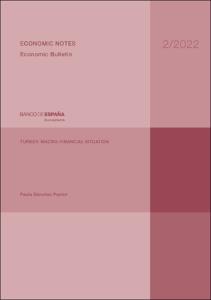Registro completo de metadatos
| Campo DC | Valor |
|---|---|
| dc.contributor.author | Sánchez Pastor, Paula |
| dc.coverage.spatial | Turquía |
| dc.date.accessioned | 2022-05-13T19:02:20Z |
| dc.date.available | 2022-05-13T19:02:20Z |
| dc.date.issued | 2022-04-25 |
| dc.identifier.uri | https://repositorio.bde.es/handle/123456789/21071 |
| dc.description | Artículo de revista |
| dc.description.abstract | Developments in the Turkish economy in the second half of 2021 and early 2022 have been strongly influenced by the course of the COVID-19 pandemic and the implementation of an economic policy framework aimed at adjusting its external position through a weaker exchange rate. More recently, Turkey has also been affected by the Russian invasion of Ukraine, due to its exposure to those countries and to its heavy energy dependence. An extraordinarily loose monetary policy has supported the continued economic buoyancy, but it has also exacerbated some of Turkey’s main pre-existing imbalances, leading to a sharp depreciation of the exchange rate and a very high inflation rate. All this has happened in a setting of large external financing needs, high levels of foreign-currency denominated debt in non-financial corporations – and, increasingly, in the public sector –, low foreign exchange reserves, and high dollarisation of bank deposits. An attempt was made to reverse the latter through the introduction of a strategy seeking to increase the weight of the Turkish lira in the economy. The banking sector remains relatively sound and its non-performing loan ratio has declined, although some of its other indicators, such as solvency ratios, have slightly worsened. |
| dc.format.extent | 17 p. |
| dc.language.iso | en |
| dc.publisher | Banco de España |
| dc.relation.ispartof | Economic Bulletin / Banco de España, 2/2022 |
| dc.relation.hasversion | Versión en español 123456789/21015 |
| dc.rights | Reconocimiento-NoComercial-CompartirIgual 4.0 Internacional (CC BY-NC-SA 4.0) |
| dc.rights | In Copyright - Non Commercial Use Permitted |
| dc.rights.uri | https://creativecommons.org/licenses/by-nc-sa/4.0/deed.es_ES |
| dc.rights.uri | http://rightsstatements.org/vocab/InC-NC/1.0/ |
| dc.subject | European Semester |
| dc.subject | Next Generation EU |
| dc.subject | Recovery and Resilience Facility |
| dc.subject | Recovery and Resilience Plan |
| dc.subject | Macroeconomic imbalances |
| dc.subject | General Escape Clause |
| dc.subject | Structural reforms |
| dc.subject | International economy |
| dc.subject | Economic situation |
| dc.title | Turkey: macro-financial situation |
| dc.type | Artículo |
| dc.identifier.bdebib | 000472809 |
| dc.identifier.bdepub | ECBU-2022-2A-nec03 |
| dc.subject.bde | Finanzas internacionales |
| dc.publisher.bde | Madrid : Banco de España, 2022 |
| dc.subject.jel | F31 |
| dc.subject.jel | F32 |
| dc.subject.jel | F34 |












